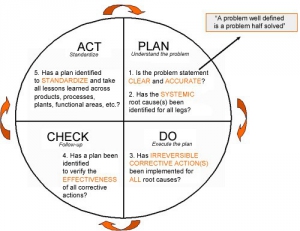

The development of the EWS is recommended to be looked at as a project (starting and ending at a given time), but the maintenance of the system is a process in order to make it sustainable. It means that the process of its operations should be overseen and monitored, the results must be analysed (what works and what does not), changed if needed and checked again when there are information on the results of the introduced improvements. The quality assured operations therefore should be cyclic and actions are recommended to be arranged in a plan-do-check-act (PDCA) cycle (see at Figure).
The plan-do-check-act cycle (PDCA)
 In the following sections the steps of developing the system is described in a PDCA logic. The cyclic development is spiral that it to say that all steps are started and revisited during the project and developments are actualized. It is suggested that mentors or the responsible person for change management encourage schools to learn the cyclic process. Institutions – within the project period - should not complete fully one step after the other (first planning until it is perfect and then moving on to doing etc.) because it is very time consuming (and time is limited within the project period) and it is also demotivating.
In the following sections the steps of developing the system is described in a PDCA logic. The cyclic development is spiral that it to say that all steps are started and revisited during the project and developments are actualized. It is suggested that mentors or the responsible person for change management encourage schools to learn the cyclic process. Institutions – within the project period - should not complete fully one step after the other (first planning until it is perfect and then moving on to doing etc.) because it is very time consuming (and time is limited within the project period) and it is also demotivating.
The steps are arranged along sets of questions which the school will have to raise to themselves. The aim is not to provide answer to those questions but to offer ways of finding the answers.
Practice has shown that cycle does not have to be started necessarily with planning. Teachers may want to start with using or piloting intervention tools and not fiddle with data gathering. There is no problem with this approach. The EWS can be built as a house, from the basement to the roof but it also could be developed as a jigsaw puzzle by trying to find little pieces that fit together. But just as with the puzzle the school management has to have a vision and find the little pieces along that. In any approach the aim is to build a system and have it operational in a given time. The system has the elements discussed above and the cyclic operational method – the “how” is up to the schools. We are showing the classic project type approach below but by no means is it the only way.
On oktataskepzes.tka.hu we use cookies to give you the best possible experience. By using this website you accept cookies.